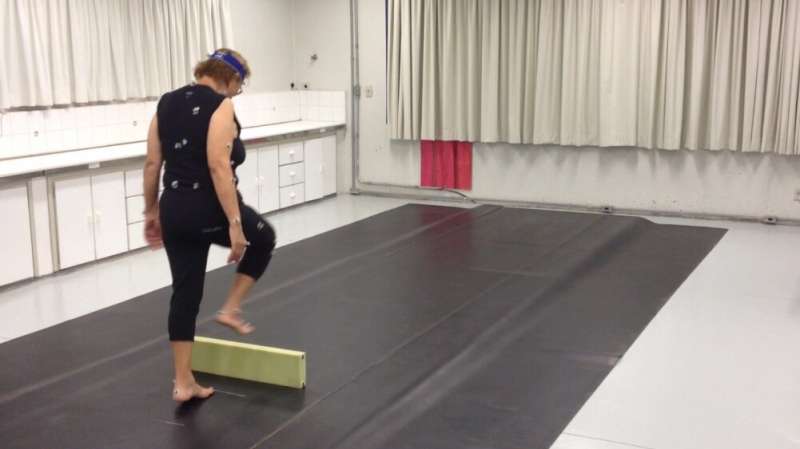
A multidisciplinary research group affiliated with the Department of Physical Education’s Human Movement Laboratory (Movi-Lab) at São Paulo State University (UNESP) in Bauru, Brazil, measured step length synergy while crossing obstacles in patients with Parkinson’s disease and concluded that it was 53% lower than in healthy subjects of the same age and weight. Step length is one of the main variables affected by the disease.
Synergy, defined as combined operation, refers in this case to the capacity of the locomotor (or musculoskeletal) system to adapt movement while crossing an obstacle, combining factors such as speed and foot position, for example. Improving synergy in Parkinson’s patients while they are walking can make a significant difference to their quality of life, as they tend to fall three times more often on average than healthy people of the same age.
“There are patients in our exercise group who fall three or four times a week. It’s important to understand how these patients’ gait and locomotion adapt while crossing obstacles so that we can improve step-length synergy. This approach enables us to refine the exercise protocol, improve locomotion, and try to reduce fall frequency,” said Fabio Augusto Barbieri, a professor in UNESP’s Department of Physical Education and its Movement Science Graduate Program.
An article on the study is published in the journal Gait & Posture. Barbieri is the last author. The first author is mechanical engineer Satyajit Ambike, a professor in the Department of Health and Kinesiology at Purdue University in the United States. The study is the first to report on impaired locomotor synergies in Parkinson’s patients.
“The innovation in our study is its focus on gait timing, or rhythmicity, the constancy with which patients position their feet to maintain locomotion,” Barbieri said. “This can be evaluated by measuring step-length synergy. Synergy presupposes a goal and has to do with the way the locomotor system adjusts to achieve it. In our case, we investigated how the system adapts to achieve the objective of crossing an obstacle during locomotion.”
The researchers found that Parkinson’s patients are less able to adapt the position of their feet than healthy people as they approach and cross an obstacle. “The locomotor system always tries to adapt in order to maintain constancy during locomotion. Absent this constancy, we may make mistakes that can lead to a fall,” Barbieri said. “Parkinson’s patients are less constant in positioning their feet while walking, and gait timing tends to be unstable as a result. Their speed rises and falls as they walk, and step length varies along with foot placement.”
Obstacles
Thirteen Parkinson’s patients and 11 neurologically healthy controls participated in the study. All participants were over 50. To be eligible they had to be able to walk without assistance, to have normal sight and hearing (with or without lenses and hearing aids), to have no orthopedic or neurological diseases apart from Parkinson’s, and to be able to understand and follow instructions. The patients took medication for Parkinson’s (Levodopa) for at least three months before data collection.
The participants had to walk along a gangway (length 8.5 m, width 3.5 m), and cross a foam rubber obstacle (height 15 cm, width 60 cm, depth 5 cm) placed 4 m from the starting point. Gait speed was not imposed but chosen by each participant. No instructions were given regarding which leg should cross the obstacle first, but its position was adjusted for each participant so that the right leg had to lead.
“We tried to standardize the task so that all the subjects crossed the obstacle with their right leg leading,” Barbieri said. “The idea was to ensure there was no interference from other factors in the locomotion pattern. The height of the obstacle was 15 cm because that’s the standard curb height in Brazil. We thought it would be best to stick to the standard.”
A number of systems need to work together for synergy to happen in terms of achieving an objective, he explained. “When the distance between the toes and the obstacle [before it is crossed] and between the heel and the obstacle [after it is crossed] varies a lot, the risk of contacting the obstacle increases. Being too close to the obstacle before crossing entails having to raise the leading leg so high that it may prove impossible. If the trailing foot comes down too close to the obstacle after crossing, the heel is likely to touch it,” he said, adding that gait timing should ideally be constant and the foot should not come too close to the obstacle on either side.
Biomechanics
Step-length synergy was measured using a methodology derived from mechanical engineering and adapted to the study of human movement. The methodology is not specific to gait analysis or Parkinson’s, but adapted from a set of techniques used to measure upper-limb strength by Ambike and Mark Latash of Pennsylvania State University.
Eight motion capture cameras used in the study were purchased with funding from FAPESP (grant no. 2017/19516-8). The study was also supported by a visiting researcher grant.
Twenty reflective markers were placed according to a specific gait analysis model on the body of each participant in the experiment. “While the subject is walking along the gangway toward the obstacle and crossing it, the cameras emit infrared light, which is reflected by the markers. The cameras capture the position of the markers, enabling us to determine step length and duration. Gait analysis software does the other calculations,” Barbieri explained.
The study was the first time this methodology was applied to gait analysis, according to Barbieri. “Another innovation was that we used a single variable to detect possible gait timing-related incapacities relatively simply, facilitating more consistent future intervention to improve gait timing via training,” he said. “This is the point of gait analysis in general. You want to determine possible variables of changes in gait and modify intervention on that basis.”
Source: Read Full Article






